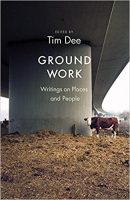Ground Work: Writings on Places and People
edited by Tim Dee
(Jonathan Cape, £16.99)
 The successors to Gilbert White, notebook-toting author in the 18th century of The Natural History and Antiquities of Selborne, have a few more tools at their disposal than he did. One, having created a mini wildflower meadow next to his Bristol allotment, is aided in his “turf-watch trance” by an app for phone and tablet that’s taught him to distinguish between species of bumblebee. Another, intent on retracing a puddled track to his Buckinghamshire boyhood, zooms in on the first 20 yards using the car-mounted camera of Google Street View. Welcome to nature writing in the Anthropocene.
The successors to Gilbert White, notebook-toting author in the 18th century of The Natural History and Antiquities of Selborne, have a few more tools at their disposal than he did. One, having created a mini wildflower meadow next to his Bristol allotment, is aided in his “turf-watch trance” by an app for phone and tablet that’s taught him to distinguish between species of bumblebee. Another, intent on retracing a puddled track to his Buckinghamshire boyhood, zooms in on the first 20 yards using the car-mounted camera of Google Street View. Welcome to nature writing in the Anthropocene. Ground Work, edited by Tim Dee, is just the thing for an age when we are making changes to our environment on such a scale, and at such a speed, that we can be reckoned a force on a par with earth-shattering asteroids and planet-cloaking volcanoes. It’s a book that reminds us of the harm we have done to everything from whales to house sparrows, but also of the good we could yet do through organisations such as Common Ground, which since the 1980s has been seeking “imaginative ways to engage people with their local environment” and which will benefit from the proceeds of this absorbing anthology. It’s a book that’s as much about the marks places leave on us as we leave on them. It offers succour rather than — in the editor’s own phrase — “sunset songs”.
Dee, who has the eyes of a birdwatcher, the ears of a radio producer and the soul of a poet, has gathered contributions from 31 people, including some art and verse (Andrew Motion on fishing) among the prose. The places celebrated range from a railed-in London park, by way of Clifton Suspension Bridge, to the deep woods of eastern Finland. As the subtitle has it, these are “Writings on Places and People”; in two where people loom large, the characters couldn’t be more different: one is a Suffolk beachcomber who reads nothing but Metal Detector magazine; the other is Peter Levi, who was professor of poetry at Oxford.
Pieces are arranged — if that’s the word — only by the surname of the contributor, opening with Barbara Bender on the Devon village of Branscombe and finishing with Ken Worpole on Clissold Park in Hackney, but even that produces striking juxtapositions. Hugh Brody, who helped document Inuit use of the Canadian Arctic, “a land unmarked by boundaries, open to all”, is followed by John Burnside on the US-Mexico border, musing on how we turn place into property by putting walls round it.
There are fine pieces, as you might expect in a work of this kind, from writers such as Richard Mabey, Mark Cocker and Helen (H is for Hawk) Macdonald. She recalls the secret garden of her childhood in Surrey that turned her into a naturalist, and her heartbreak, on returning in her forties, to find that the meadow she remembered was now as neat and blank as a lawn. With its loss, she says, “part of me disappeared too, or, rather, passed from existence into a memory that even now batters inside my chest”. Yet she has hope of restoration: “Those clouds of butterflies have met with local extinction, but held in that soil is a bank of seeds that will hang on. They will hang on for a very long time.”
Among the contributors are plenty who wouldn’t usually be categorised as nature writers. The cultural historian Alexandra Harris, returning to the West Sussex landscape where she grew up, fears (wrongly) that she’s not up to describing it because she can’t name the sedges she thought she liked so much; she feels that “to describe a place you’re meant to know it intimately… to have been its active cultivator and guardian”.
The novelist Tessa Hadley admits that she would “rather look out over gardens than be responsible for them”, and frets less about lacking the language of a naturalist. Having moved from a big family house in Cardiff to a two-bedroom flat in London, she revels in the comparative greenness of her new city and what she can see from the windows of her neighbours’ plots. Her piece is proof that you don’t have to work turf, or even walk on it, to get a lift from it. Indeed, as this wonderful anthology demonstrates, reading about it will do the trick. MK
This review appeared first in The Daily Telegraph on April 14, 2018
